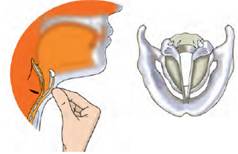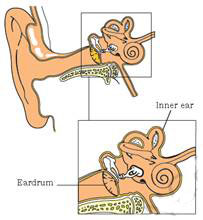When a tightly stretched band is plucked, it vibrates and produces sound. When it stops vibrating, it does not produce any sound.
We see that a vibrating object produces sound. In some cases, the vibrations are easily visible to us. But in most cases, their amplitude is so small that we cannot see them. However, we can feel them.
In humans, the sound is produced by the voice box or the larynx. Put your fingers on the throat and find a hard bump that seems to move when you swallow.

This part of the body is known as the voice box. It is at the upper end of the windpipe. Two vocal cords, are stretched across the voice box or larynx in such a way that it leaves a narrow slit between them for the passage of air.
When the lungs force air through the slit, the vocal cords vibrate, producing sound. Muscles attached to the vocal cords can make the cords tight or loose.
Actually, sound needs a medium to travel. When air has been removed completely from a vessel, it is said that there is a vacuum in the vessel. The sound cannot travel through a vacuum.
When air has been removed completely from a vessel, it is said that there is a vacuum in the vessel.
The shape of the outer part of the ear is like a funnel. When sound enters it, it travels down a canal at the end of which there is a thin stretched membrane. It is called the eardrum. It performs an important function.

The eardrum is like a stretched rubber sheet. Sound vibrations make the eardrum vibrate. The eardrum sends vibrations to the inner ear. From there, the signal goes to the brain. That is how we hear.
The number of oscillations per second is called the frequency of oscillation. Frequency is expressed in hertz. Its symbol is Hz. A frequency of 1 Hz is one oscillation per second.
Some sounds without seeing the objects producing them. Amplitude and frequency are two important properties of any sound.
The loudness of sound depends on its amplitude. When the amplitude of vibration is large, the sound produced is loud. When the amplitude is small, the sound produced is feeble.
The frequency determines the shrillness or pitch of a sound. If the frequency of vibration is higher we say that the sound is shrill and has a higher pitch. If the frequency of vibration is lower, we say that the sound has a lower pitch.
The sounds of frequencies less than about 20 vibrations per second (20 Hz) cannot be detected by the human ear. Such sounds are called inaudible. On the higher side, sounds of frequencies higher than about 20,000 vibrations per second (20 kHz) are also not audible to the human ear.
Thus, for human ear, the range of audible frequencies is roughly from 20 to 20,000 Hz.
Some sounds are pleasant to the ear, whereas some are not. Unpleasant sounds are called noise.
When enjoy sounds from musical instruments. Musical sound is one which is pleasing to the ear. Sound produced by a harmonium is a musical sound.
Presence of unwanted gases and particles in air is called air pollution. Similarly, presence of excessive or unwanted sounds in the environment is called noise pollution.
Causes of noise pollution are sounds of vehicles, explosions including bursting of crackers, machines, loudspeakers etc.
Presence of excessive noise in the surroundings may cause many health related problems. Lack of sleep, hypertension (high bloodpressure), anxiety and many more health disorders may be caused by noise pollution.
To control noise, we must control the sources of noise. All noisy operations must be conducted away from any residential area. Noise producing industries should be set up away from such areas.
